翻译基本知识
- 格式:ppt
- 大小:1.39 MB
- 文档页数:2
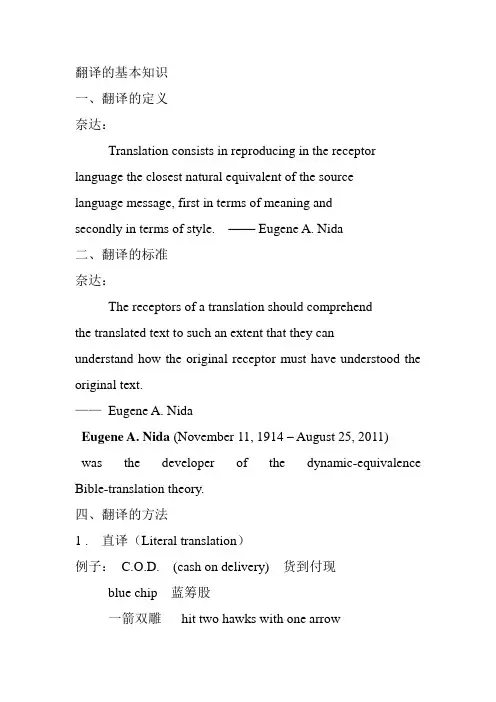
翻译的基本知识一、翻译的定义奈达:Translation consists in reproducing in the receptor language the closest natural equivalent of the sourcelanguage message, first in terms of meaning andsecondly in terms of style. —— Eugene A. Nida二、翻译的标准奈达:The receptors of a translation should comprehendthe translated text to such an extent that they canunderstand how the original receptor must have understood the original text.——Eugene A. NidaEugene A. Nida (November 11, 1914 – August 25, 2011)was the developer of the dynamic-equivalence Bible-translation theory.四、翻译的方法1 . 直译(Literal translation)例子: C.O.D. (cash on delivery) 货到付现blue chip 蓝筹股一箭双雕hit two hawks with one arrow意译(Free translation)例子:WPA 水渍blue chip 绩优股一箭双雕kill two birds with one stone一、广告的定义Advertising is the non-personal communication ofinformation usually paid for and usually persuasive innature about products, services or ideas by identifiedsponsors through the various media.—— American Marketing Association二、广告的分类1.理性广告(Rational ads)情感广告(Emotional ads)三、广告的组成部分1.Headline Subhead Text (body) Logo sloganI’m lovin’ it! (麦当劳)我就喜欢!Good to the last drop. (Maxwell coffee)滴滴香浓,意犹未尽。
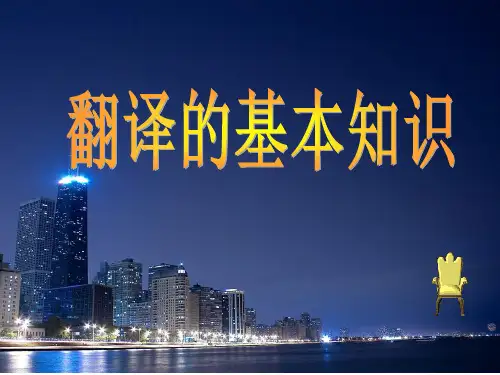
一、翻译的定义什么时候有了一个民族或部落同另一个民族或部落的接触,什么时候就有了翻译。
西方自一世纪、中国自商周时期开始就有了跨语言翻译(inter-lingual translation)。
唐代贾公彦在《义疏》中写道:“译即易,谓换易言语使相解也。
”《辞源》对翻译的解释是:“用一种语言表达他种语文的意思。
”《大英百科全书》:“将用一种语言或者一套语言符号所表示的内容用另一种语言或者一套语言符号进行转换的行为或者过程。
”对于翻译较为完整的定义,要数现代翻译家奈达的:Translation consists in producing in the receptor language the closestnatural equivalent of the source language message, first in terms of meaning and secondly in terms of style.即所谓翻译,是指从语义到文体上在译语中用最切近而且最自然的对等语再现原语的信息,首先在语义上,其次在文体上。
人物简介贾公彦-贾公彦(生卒年不详,活动期公元7世纪中叶)中国唐代学者。
铭州永年(今河北永年县)人,唐高宗永徽元年(650年)发现指纹的特征及用途。
他官至太学博士。
撰《周礼义疏》50卷、《仪礼义疏》40卷。
指纹是手指远端掌面的凹凸花纹。
由长短、形状、粗细、结构不同的纹线组成,分弓、箕、斗三种基本类型,具有终生不变、各不相同的特点。
因此,指纹被广泛用作侦破案件、人身保险、研究遗传疾病和人的自然素质的依据,成为法医学和遗传学等学科的重要研究课题。
据德国R·海因德尔撰写的《指纹鉴定》(1927年)一书中指出:“世界上第一个用作鉴定的指纹的著作者是中国唐朝的贾公彦,他是唐代的著作家。
他的作品大约写于公元650年,他是着重指出指纹是确认个人的方法的第一人”。
贾公彦,其字不详,唐州永年(今河北邯郸市东北)人。
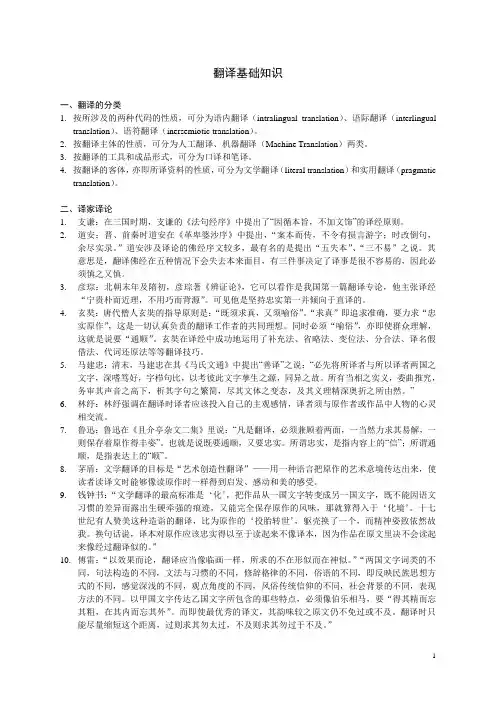
翻译基础知识一、翻译的分类1.按所涉及的两种代码的性质,可分为语内翻译(intralingual translation)、语际翻译(interlingualtranslation)、语符翻译(inersemiotic translation)。
2.按翻译主体的性质,可分为人工翻译、机器翻译(Machine Translation)两类。
3.按翻译的工具和成品形式,可分为口译和笔译。
4.按翻译的客体,亦即所译资料的性质,可分为文学翻译(literal translation)和实用翻译(pragmatictranslation)。
二、译家译论1.支谦:在三国时期,支谦的《法句经序》中提出了“因循本旨,不加文饰”的译经原则。
2.道安:晋、前秦时道安在《革卑婆沙序》中提出,“案本而传,不令有损言游字;时改倒句,余尽实录。
”道安涉及译论的佛经序文较多,最有名的是提出“五失本”、“三不易”之说。
其意思是,翻译佛经在五种情况下会失去本来面目,有三件事决定了译事是很不容易的,因此必须慎之又慎。
3.彦琮:北朝末年及隋初,彦琮著《辨证论》,它可以看作是我国第一篇翻译专论,他主张译经“宁贵朴而近理,不用巧而背源”。
可见他是坚持忠实第一并倾向于直译的。
4.玄奘:唐代僧人玄奘的指导原则是:“既须求真,又须喻俗”。
“求真”即追求准确,要力求“忠实原作”,这是一切认真负责的翻译工作者的共同理想。
同时必须“喻俗”,亦即使群众理解,这就是说要“通顺”。
玄奘在译经中成功地运用了补充法、省略法、变位法、分合法、译名假借法、代词还原法等等翻译技巧。
5.马建忠:清末,马建忠在其《马氏文通》中提出“善译”之说:“必先将所译者与所以译者两国之文字,深嗜笃好,字栉句比,以考彼此文字孳生之源,同异之故。
所有当相之实义,委曲推究,务审其声音之高下,析其字句之繁简,尽其文体之变态,及其义理精深奥折之所由然。
”6.林纾:林纾强调在翻译时译者应该投入自己的主观感情,译者须与原作者或作品中人物的心灵相交流。
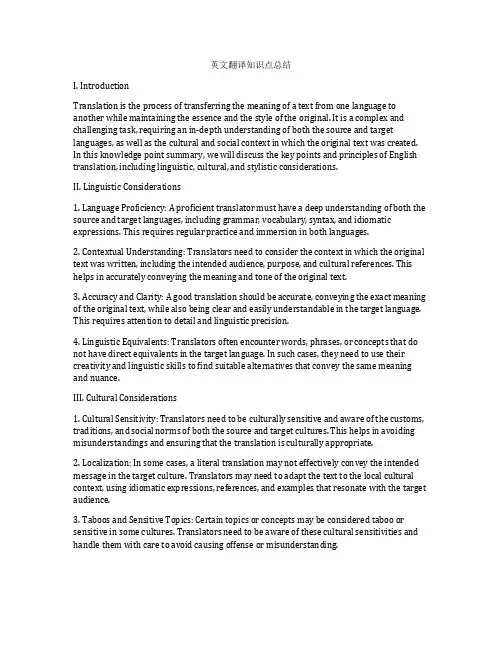
英文翻译知识点总结I. IntroductionTranslation is the process of transferring the meaning of a text from one language to another while maintaining the essence and the style of the original. It is a complex and challenging task, requiring an in-depth understanding of both the source and target languages, as well as the cultural and social context in which the original text was created. In this knowledge point summary, we will discuss the key points and principles of English translation, including linguistic, cultural, and stylistic considerations.II. Linguistic Considerations1. Language Proficiency: A proficient translator must have a deep understanding of both the source and target languages, including grammar, vocabulary, syntax, and idiomatic expressions. This requires regular practice and immersion in both languages.2. Contextual Understanding: Translators need to consider the context in which the original text was written, including the intended audience, purpose, and cultural references. This helps in accurately conveying the meaning and tone of the original text.3. Accuracy and Clarity: A good translation should be accurate, conveying the exact meaning of the original text, while also being clear and easily understandable in the target language. This requires attention to detail and linguistic precision.4. Linguistic Equivalents: Translators often encounter words, phrases, or concepts that do not have direct equivalents in the target language. In such cases, they need to use their creativity and linguistic skills to find suitable alternatives that convey the same meaning and nuance.III. Cultural Considerations1. Cultural Sensitivity: Translators need to be culturally sensitive and aware of the customs, traditions, and social norms of both the source and target cultures. This helps in avoiding misunderstandings and ensuring that the translation is culturally appropriate.2. Localization: In some cases, a literal translation may not effectively convey the intended message in the target culture. Translators may need to adapt the text to the local cultural context, using idiomatic expressions, references, and examples that resonate with the target audience.3. Taboos and Sensitive Topics: Certain topics or concepts may be considered taboo or sensitive in some cultures. Translators need to be aware of these cultural sensitivities and handle them with care to avoid causing offense or misunderstanding.4. Historical and Political Context: Historical and political references in the original text may not be readily understood in the target culture. Translators need to provide explanations or contextual information to help the reader grasp the significance of these references.IV. Stylistic Considerations1. Register and Tone: Translators need to match the register and tone of the original text in the target language, whether it is formal, informal, technical, or literary. This ensures that the translation reflects the style and voice of the original author.2. Cohesion and Coherence: A good translation maintains the cohesion and coherence of the original text, ensuring that the ideas flow logically and smoothly in the target language. This requires careful attention to transitions, pronoun references, and sentence structure.3. Rhythm and Style: In literary translations, the rhythm and style of the original work need to be preserved to the extent possible. This may involve creative choices in the use of language and imagery that capture the essence of the original.4. Idiomatic Expressions: Translators need to be adept at handling idiomatic expressions, proverbs, and wordplay, finding creative ways to convey the same meaning and impact in the target language.V. Practical Considerations1. Translation Tools: Translators often use computer-assisted translation tools, such as CAT software, dictionaries, and glossaries, to aid in the translation process. These tools can help maintain consistency and accuracy across large or complex projects.2. Proofreading and Editing: A thorough proofreading and editing process is essential to ensure the quality and accuracy of the translation. This may involve multiple revisions and feedback from other language experts.3. Specialized Knowledge: Translating technical, medical, legal, or scientific texts may require specialized knowledge and terminology in the relevant fields. Translators need to familiarize themselves with the specific language and conventions of these domains.4. Client and Audience Expectations: Translators need to understand the needs and expectations of their clients or target audience, whether it is for marketing, education, entertainment, or information. Adapting the translation to meet these expectations is crucial.VI. ConclusionIn conclusion, English translation is a multifaceted process that requires a deep understanding of linguistic, cultural, and stylistic considerations. It demands a high level of language proficiency, cultural sensitivity, and creativity to produce accurate and effectivetranslations. By mastering these key points and principles, translators can bring the richness and diversity of the world's languages and cultures to a global audience.。
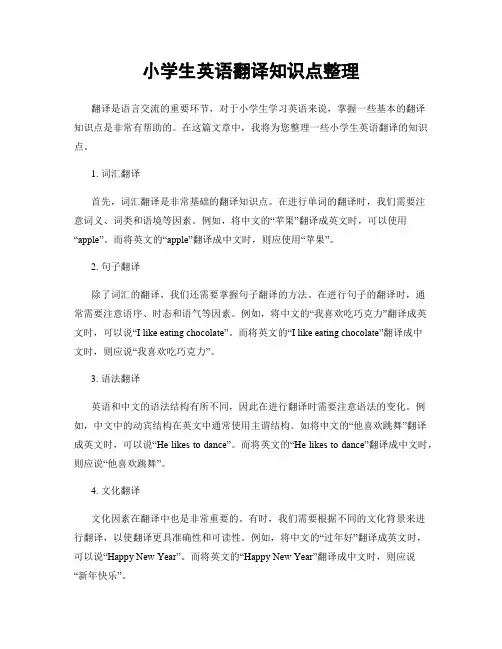
小学生英语翻译知识点整理翻译是语言交流的重要环节,对于小学生学习英语来说,掌握一些基本的翻译知识点是非常有帮助的。
在这篇文章中,我将为您整理一些小学生英语翻译的知识点。
1. 词汇翻译首先,词汇翻译是非常基础的翻译知识点。
在进行单词的翻译时,我们需要注意词义、词类和语境等因素。
例如,将中文的“苹果”翻译成英文时,可以使用“apple”。
而将英文的“apple”翻译成中文时,则应使用“苹果”。
2. 句子翻译除了词汇的翻译,我们还需要掌握句子翻译的方法。
在进行句子的翻译时,通常需要注意语序、时态和语气等因素。
例如,将中文的“我喜欢吃巧克力”翻译成英文时,可以说“I like eating chocolate”。
而将英文的“I like eating chocolate”翻译成中文时,则应说“我喜欢吃巧克力”。
3. 语法翻译英语和中文的语法结构有所不同,因此在进行翻译时需要注意语法的变化。
例如,中文中的动宾结构在英文中通常使用主谓结构。
如将中文的“他喜欢跳舞”翻译成英文时,可以说“He likes to dance”。
而将英文的“He likes to dance”翻译成中文时,则应说“他喜欢跳舞”。
4. 文化翻译文化因素在翻译中也是非常重要的。
有时,我们需要根据不同的文化背景来进行翻译,以使翻译更具准确性和可读性。
例如,将中文的“过年好”翻译成英文时,可以说“Happy New Year”。
而将英文的“Happy New Year”翻译成中文时,则应说“新年快乐”。
5. 上下文翻译在翻译过程中,上下文也是需要考虑的关键因素之一。
有时一个词汇或句子的翻译需要依赖于上下文来确定其准确含义。
例如,将中文的“他很酷”翻译成英文时,如果上下文是在形容一个人很帅或很厉害,可以说“He's cool”。
而如果上下文是在形容一个人态度冷漠或不友善,可以说“He's cold”。
6. 实践积累最后,对于小学生来说,通过大量的实践翻译积累也是非常重要的。
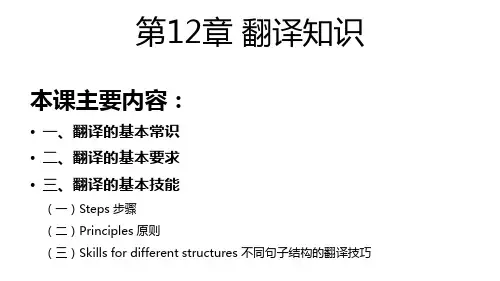
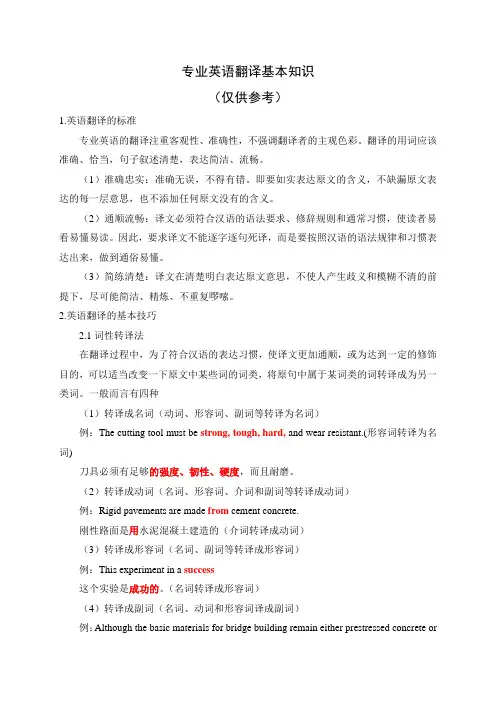
专业英语翻译基本知识(仅供参考)1.英语翻译的标准专业英语的翻译注重客观性、准确性,不强调翻译者的主观色彩。
翻译的用词应该准确、恰当,句子叙述清楚,表达简洁、流畅。
(1)准确忠实:准确无误,不得有错。
即要如实表达原文的含义,不缺漏原文表达的每一层意思,也不添加任何原文没有的含义。
(2)通顺流畅:译文必须符合汉语的语法要求、修辞规则和通常习惯,使读者易看易懂易读。
因此,要求译文不能逐字逐句死译,而是要按照汉语的语法规律和习惯表达出来,做到通俗易懂。
(3)简练清楚:译文在清楚明白表达原文意思,不使人产生歧义和模糊不清的前提下,尽可能简洁、精炼、不重复啰嗦。
2.英语翻译的基本技巧2.1词性转译法在翻译过程中,为了符合汉语的表达习惯,使译文更加通顺,或为达到一定的修饰目的,可以适当改变一下原文中某些词的词类,将原句中属于某词类的词转译成为另一类词。
一般而言有四种(1)转译成名词(动词、形容词、副词等转译为名词)例:The cutting tool must be strong, tough, hard, and wear resistant.(形容词转译为名词)刀具必须有足够的强度、韧性、硬度,而且耐磨。
(2)转译成动词(名词、形容词、介词和副词等转译成动词)例:Rigid pavements are made from cement concrete.刚性路面是用水泥混凝土建造的(介词转译成动词)(3)转译成形容词(名词、副词等转译成形容词)例:This experiment in a success这个实验是成功的。
(名词转译成形容词)(4)转译成副词(名词、动词和形容词译成副词)例:Although the basic materials for bridge building remain either prestressed concrete orsteel, there have been some recent changes尽管建桥的基本材料仍然是预应力混凝土或钢材,但近来已经有些变化了。
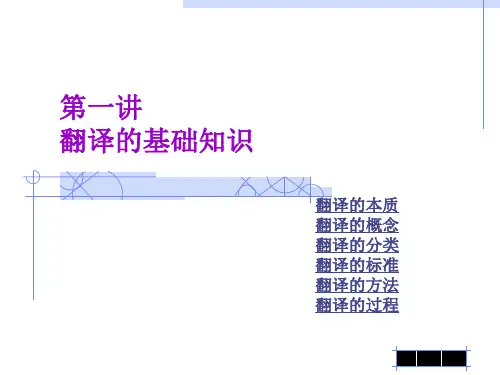
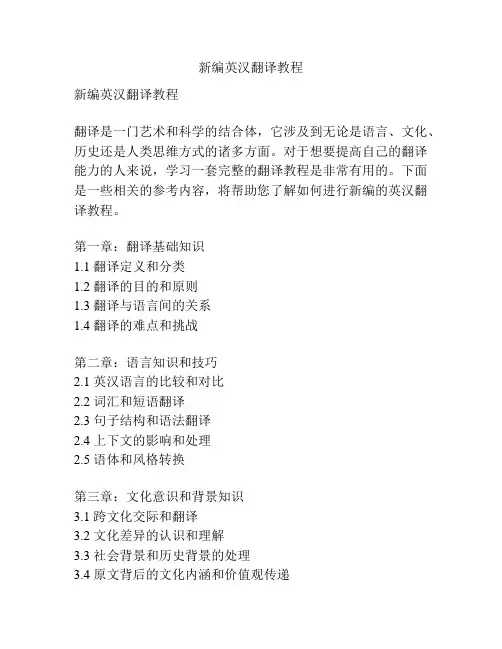
新编英汉翻译教程新编英汉翻译教程翻译是一门艺术和科学的结合体,它涉及到无论是语言、文化、历史还是人类思维方式的诸多方面。
对于想要提高自己的翻译能力的人来说,学习一套完整的翻译教程是非常有用的。
下面是一些相关的参考内容,将帮助您了解如何进行新编的英汉翻译教程。
第一章:翻译基础知识1.1 翻译定义和分类1.2 翻译的目的和原则1.3 翻译与语言间的关系1.4 翻译的难点和挑战第二章:语言知识和技巧2.1 英汉语言的比较和对比2.2 词汇和短语翻译2.3 句子结构和语法翻译2.4 上下文的影响和处理2.5 语体和风格转换第三章:文化意识和背景知识3.1 跨文化交际和翻译3.2 文化差异的认识和理解3.3 社会背景和历史背景的处理3.4 原文背后的文化内涵和价值观传递第四章:专业领域和行业知识4.1 法律翻译原则和技巧4.2 医学翻译原则和技巧4.3 经济与商务翻译原则和技巧4.4 技术与科学翻译原则和技巧第五章:翻译工具和资源5.1 电子词典和在线翻译工具的使用5.2 术语库和翻译记忆库的建立和管理5.3 翻译软件的使用和技巧5.4 翻译资源和参考文献的查找和使用第六章:翻译实践和技巧6.1 阅读和理解原文的重要性6.2 提高译文的准确性和流畅度6.3 校对和修改译文的技巧6.4 学习和借鉴他人的优秀翻译作品第七章:发展和推广翻译技能7.1 参加翻译考试和认证7.2 加入翻译协会和社区7.3 进修和继续教育的机会7.4 与客户和雇主建立有效的沟通通过学习以上内容,您将逐步掌握新编英汉翻译的基本理论和技巧。
同时,您还可以在实践中不断提高自己的翻译能力,并且了解如何将翻译技能应用到不同的专业领域中。
通过继续学习和积累实践经验,您将成为一名优秀的英汉翻译专业人员。
值得一提的是,在学习翻译过程中,积极参与翻译实践是至关重要的。
可以选择翻译新闻、文学作品、商业文件等不同类型的材料,并进行翻译和校对实践。
此外,与他人分享您的翻译作品、参加翻译比赛和与其他翻译专业人士的交流也是提高翻译能力的有效途径。
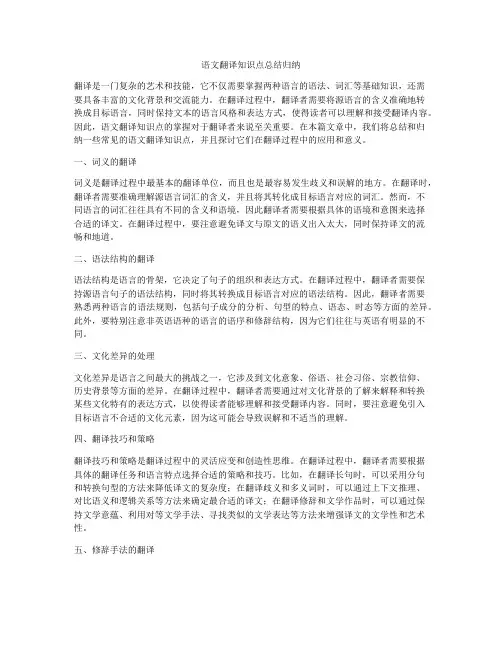
语文翻译知识点总结归纳翻译是一门复杂的艺术和技能,它不仅需要掌握两种语言的语法、词汇等基础知识,还需要具备丰富的文化背景和交流能力。
在翻译过程中,翻译者需要将源语言的含义准确地转换成目标语言,同时保持文本的语言风格和表达方式,使得读者可以理解和接受翻译内容。
因此,语文翻译知识点的掌握对于翻译者来说至关重要。
在本篇文章中,我们将总结和归纳一些常见的语文翻译知识点,并且探讨它们在翻译过程中的应用和意义。
一、词义的翻译词义是翻译过程中最基本的翻译单位,而且也是最容易发生歧义和误解的地方。
在翻译时,翻译者需要准确理解源语言词汇的含义,并且将其转化成目标语言对应的词汇。
然而,不同语言的词汇往往具有不同的含义和语境,因此翻译者需要根据具体的语境和意图来选择合适的译文。
在翻译过程中,要注意避免译文与原文的语义出入太大,同时保持译文的流畅和地道。
二、语法结构的翻译语法结构是语言的骨架,它决定了句子的组织和表达方式。
在翻译过程中,翻译者需要保持源语言句子的语法结构,同时将其转换成目标语言对应的语法结构。
因此,翻译者需要熟悉两种语言的语法规则,包括句子成分的分析、句型的特点、语态、时态等方面的差异。
此外,要特别注意非英语语种的语言的语序和修辞结构,因为它们往往与英语有明显的不同。
三、文化差异的处理文化差异是语言之间最大的挑战之一,它涉及到文化意象、俗语、社会习俗、宗教信仰、历史背景等方面的差异。
在翻译过程中,翻译者需要通过对文化背景的了解来解释和转换某些文化特有的表达方式,以使得读者能够理解和接受翻译内容。
同时,要注意避免引入目标语言不合适的文化元素,因为这可能会导致误解和不适当的理解。
四、翻译技巧和策略翻译技巧和策略是翻译过程中的灵活应变和创造性思维。
在翻译过程中,翻译者需要根据具体的翻译任务和语言特点选择合适的策略和技巧。
比如,在翻译长句时,可以采用分句和转换句型的方法来降低译文的复杂度;在翻译歧义和多义词时,可以通过上下文推理、对比语义和逻辑关系等方法来确定最合适的译文;在翻译修辞和文学作品时,可以通过保持文学意蕴、利用对等文学手法、寻找类似的文学表达等方法来增强译文的文学性和艺术性。
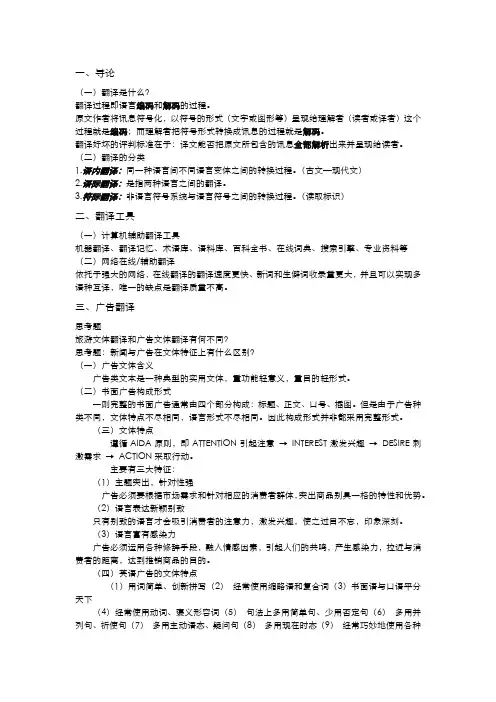
一、导论(一)翻译是什么?翻译过程即语言编码和解码的过程。
原文作者将讯息符号化,以符号的形式(文字或图形等)呈现给理解者(读者或译者)这个过程就是编码;而理解者把符号形式转换成讯息的过程就是解码。
翻译好坏的评判标准在于:译文能否把原文所包含的讯息全部解析出来并呈现给读者。
(二)翻译的分类1.语内翻译:同一种语言间不同语言变体之间的转换过程。
(古文—现代文)2.语际翻译:是指两种语言之间的翻译。
3.符际翻译:非语言符号系统与语言符号之间的转换过程。
(读取标识)二、翻译工具(一)计算机辅助翻译工具机器翻译、翻译记忆、术语库、语料库、百科全书、在线词典、搜索引擎、专业资料等(二)网络在线/辅助翻译依托于强大的网络,在线翻译的翻译速度更快、新词和生僻词收录量更大,并且可以实现多语种互译,唯一的缺点是翻译质量不高。
三、广告翻译思考题旅游文体翻译和广告文体翻译有何不同?思考题:新闻与广告在文体特征上有什么区别?(一)广告文体含义广告类文本是一种典型的实用文体,重功能轻意义,重目的轻形式。
(二)书面广告构成形式一则完整的书面广告通常由四个部分构成:标题、正文、口号、插图。
但是由于广告种类不同,文体特点不尽相同,语言形式不尽相同。
因此构成形式并非都采用完整形式。
(三)文体特点遵循AIDA原则,即ATTENTION引起注意→INTEREST激发兴趣→DESIRE刺激需求→ACTION采取行动。
主要有三大特征:(1)主题突出,针对性强广告必须要根据市场需求和针对相应的消费者群体,突出商品别具一格的特性和优势。
(2)语言表达新颖别致只有别致的语言才会吸引消费者的注意力,激发兴趣,使之过目不忘,印象深刻。
(3)语言富有感染力广告必须运用各种修辞手段,融入情感因素,引起人们的共鸣,产生感染力,拉近与消费者的距离,达到推销商品的目的。
(四)英语广告的文体特点(1)用词简单、创新拼写(2)经常使用缩略语和复合词(3)书面语与口语平分天下(4)经常使用动词、褒义形容词(5)句法上多用简单句、少用否定句(6)多用并列句、祈使句(7)多用主动语态、疑问句(8)多用现在时态(9)经常巧妙地使用各种修辞手段(五)中文广告的文体特点(1)用词简洁,多用四字结构词语(2)经常使用动词、褒义形容词(3)经常套用诗词,偏爱对偶和押韵等(4)书面语与口语并存(5)句法上多用散句、少用复合句(6)多用并列句、省略句和祈使句(7)经常巧妙地使用各种修辞手段(六)广告文体的翻译原则翻译广告时,首先充分理解广告的语义,然后依照广告的功用,借鉴汉语广告文体特征构建新的汉语文本。
古诗翻译知识点总结一、翻译原则1.忠实原文翻译应忠实于原文,力求原文的意义和情感在译文中得到最完整的体现。
在翻译时,要尽量保持原诗的韵律、格律和修辞特色,使译文尽可能接近原作的格调和风采。
2.重视意蕴翻译不仅要注重文字的翻译,更要重视其中的意蕴,因为古诗大多是以寥寥数语表达出丰富的情感和意蕴,翻译要力求准确传达原诗的意思和情感。
3.语言表达翻译不仅要忠实于原文,更要考虑到译文的语言表达方式,使诗歌能够在另一种语言环境中展现出其美感和魅力。
4.文化转换古诗翻译需要考虑不同文化之间的转换,译者需要有丰富的文化背景知识,理解原诗中的文化内涵,以便更好地传达原诗的意义。
二、翻译技巧1.注重音韵古诗的韵律和格律是其重要特征之一,翻译时要尽可能保持原文的音韵特点,如平仄、押韵等,使译文在音乐上和原作相近。
2.选词准确在翻译时要选择准确恰当的词语,使译文与原文在语义和修辞方面尽可能保持一致,要注重选词的美感和韵味。
3.翻译意境古诗以意境为重要特点,翻译时要将原诗的意境与情感尽可能地表现出来,使译文具有相似的意境感染力。
4.转换文化符号古诗中常常包含大量的文化符号和象征意义,译者需要对文化符号进行恰当的转换和说明,以便读者能够理解原诗中蕴含的文化内涵。
5.灵活运用修辞手法古诗中常常使用各种修辞手法,如比喻、拟人、夸张等,译者需要灵活运用修辞手法,以使译文更加生动有趣。
三、常见问题1.意译与直译古诗翻译中,常常会遇到一些需要意译的地方,译者需要权衡原诗的意思和语言表达方式,进行适当的意译,使译文能够更好地传达原诗的情感和意境。
2.平衡忠实与通顺在翻译古诗时,需要权衡忠实于原诗的原则和译文的通顺性,以达到平衡的最佳效果。
3.文化差异古诗翻译需要充分考虑到不同文化之间的差异,译者需要了解原诗中的文化内涵,并将其转换成目标语言能够理解的表达方式。
四、翻译实践1.多读多练熟悉原诗的语言特点和文化内涵是译者的基本功,多读原诗,多练习翻译,以提高翻译的准确性和质量。
英语翻译的知识点英语翻译是一门十分专业的英语学问,随着我国向国际化迈进的步伐越来越快,对于英语翻译专业人才的需求也越来越旺盛。
接下来为你整理了英语翻译的知识点,一起来看看吧。
英语翻译的基础知识1. 异化(foreignization) 和归化(domestication)保留原语所包含的文化、形象色彩,叫异化,读者通过这样的译文可以感受到异域文化的东西。
例如,把crocodile tears 译为鳄鱼泪,就是异化的翻译方法;舍弃原语所包含的文化、形象色彩,取而代之用译文的文化色彩,或者牺牲这种文化色彩而只翻译出其意义就是归化,就是让原文“归顺”于译文。
例如把crocodile tears 译为假惺惺的眼泪,就是归化的翻译方法。
2. 直译(literal translation) 和意译(free translation) 直译即照着原文直接翻译,例如藏龙卧虎– Hidden dragons and hidden tigers. 意译就是抛弃原文形式而只传达其意义,例如Dutch courage – 酒后之勇3. 音译(transliteration) 比如:store – 士多cheese –汁斯风水–fungshui4. 翻译的标准:信达雅faithfulness, expressiveness, elegance “信”指的是忠实于原文的内容和风格(faithful to thecontent and style of the source text;“达”指的是译文语言流畅自然而不生硬阻滞(the translation or target text should be natural and expressive);“雅”指的是译文译文语言风格尽可能贴近原文风格。
5. 词类的转化conversion :名词动词形容词副词根据表达需要,在翻译中,往往需要进行词类的转化,此外,还包括抽象与具体的转化。
翻译专业必备知识点总结作为翻译专业的学生或者从业者,掌握一定的翻译知识点是非常重要的。
下面将总结一些翻译专业必备知识点,包括语言能力、文化背景、翻译技巧等方面,希望能够对翻译专业的学习和工作有所帮助。
一、语言能力1.掌握源语言和目标语言的语法、词汇和语音知识,包括词义、词性、句法、语法等方面的知识。
2.熟练运用目标语言的表达方式和语言特点,包括语言的地道性、习惯用语、俚语等,使翻译更为准确和自然。
3.了解源语言和目标语言的语言特点和文化差异,避免直译和死译,做到符合目标语言的语言习惯和表达习惯。
4.具备良好的口译能力,包括听力、口语表达和笔记能力,在需要时能够进行即时口译。
5.具备良好的书面翻译能力,包括阅读理解、翻译表达和整理编辑能力,保证翻译的准确性和流畅性。
二、文化背景1. 了解源语言和目标语言国家和地区的文化特点,包括宗教、习俗、历史、风俗等方面的知识。
2.掌握源语言和目标语言的文学、艺术和历史知识,以便更好地理解和翻译相关内容。
3.了解不同国家和地区的政治、经济和社会制度,尤其是对于国际新闻、商务文档等方面的翻译更为重要。
4. 针对不同的翻译项目,需要针对性地了解相关的文化背景知识,以便更好地把握翻译的内容和情感。
5.与此同时,要保持跨文化交流的开放心态,不断学习和完善自己的跨文化能力,提高与不同文化背景人士的交流能力。
三、翻译技巧1.对于不同类型的翻译项目,采用不同的翻译方法和策略,包括直译、意译、变通译等。
2.善于利用翻译工具,如电子词典、翻译软件等,提高翻译效率和准确性。
3.善于分析和解决翻译中出现的问题,包括句子结构不同、词义相同、语言习惯不同等问题。
4.培养自己的阅读能力,提高理解和表达能力,不断拓展自己的知识面,以应对各种翻译需求。
5.加强实践经验,多参与各种翻译项目,锻炼自己的翻译能力和应变能力。
四、其他1.保持良好的心理素质,包括耐心、细心、自控能力等,以应对翻译过程中可能出现的各种困难和压力。
翻译如何入门知识点总结翻译是一门充满挑战的艺术和技能,它不仅要求译者有深厚的语言功底,还要求译者对不同领域有一定的了解和掌握,更重要的是要有耐心和细心。
对于初学者来说,学习翻译需要从基础知识开始,逐步加深理解并不断练习。
下面将从翻译的基本概念、步骤和技巧等方面总结入门知识点,帮助初学者快速入门。
一、基本概念1. 翻译的定义翻译是将一种语言的文字或口语表达转换为另一种语言的过程。
它不仅仅是简单的语言转换,更多的是要求译者要准确地理解原文的意思,并用目标语言恰当地表达出来。
2. 翻译的分类翻译可以分为口译和笔译两种形式。
口译是指将口语进行翻译,而笔译则是将书面文字进行翻译。
根据翻译的领域不同,又可以分为文学翻译、商务翻译、科技翻译等多种类型。
3. 翻译的特点翻译具有跨文化交流的特点,它需要译者具备良好的语言能力和跨文化交流能力。
此外,翻译还要求译者具备良好的解释能力和逻辑思维能力,以便准确表达原文意思。
二、翻译的步骤1. 理解原文翻译的第一步是要仔细阅读和理解原文的内容。
译者应该尽量准确地理解原文的语言和文化背景,把握原文的主旨和要表达的意思。
2. 查找词典和资料在翻译过程中,译者可能会遇到一些不熟悉或难以理解的词语和表达方式,这时就需要查找相关的词典和资料,帮助理解和翻译。
3. 选择合适的译文在理解原文的基础上,译者需要选择合适的译文表达出来。
译文要求准确、通顺、地道,符合目标语言的表达习惯。
4. 逐句翻译译者可以根据原文的结构和逻辑,逐句进行翻译。
在这个过程中,译者需要不断调整和修改译文,保证其准确和通顺。
5. 校对和修改翻译完成后,译者需要进行校对和修改。
通过反复比对原文和译文,检查是否有疏漏和错误,保证译文的准确性和通顺性。
三、翻译的技巧1. 保持灵活翻译过程中,译者需要保持灵活的思维和表达方式。
有时候原文的表达方式可能与目标语言有所差异,译者需要灵活运用语言,使译文更为贴切和地道。
2. 注意语言的风格不同的文体和不同的领域有不同的语言风格,在翻译过程中,译者需要注意语言的风格和用词习惯,力求表达出与原文相同的语言特点。
第一章翻译的基本概念与知识Part l.翻译溯源1.1唐时期的佛经翻译早在西汉哀帝时期,有个叫伊存的人到中国来口传一些简短的佛教经句但不是真正意义的佛经翻译。
西汉武帝时期张骞出使西域,接触了佛经,从此,拉开了佛经翻译的序幕。
佛经的翻译正式始于东汉桓帝建和二年。
波斯人安世高翻译了《安般守意经》等三十多部经书;竺法护翻译了175部经书,对佛教的流传作出了巨大的贡献。
此外,安清、支亮、支谦等在当时也很有必要名气。
东晋到隋时期的翻译事业有了进一步的发展。
道安主持译场,严格主张直译,还请来印度人鸠摩罗什Kumarajiva。
鸠摩罗什一改古直风格,主张意译,译著有《金刚经》、《法华经》等三百余卷,为我国的翻译文学奠定了基础。
南北朝时期的印度学者真谛Paramartha翻译了《摄大乘论》等49部经论,对中国的佛教思想有较大的影响。
唐朝,是我国佛经翻译的鼎盛时期,翻译大家玄奘在唐太宗贞观二年去印度取经,历时间17年,带回佛经657部,《西游记》A Pilgrimage to the West便是以他的取经经历为蓝本的。
在19年里,共翻译山75部佛经,多达1335卷,1300多万字。
他不仅把佛经翻译成汉语,而且是将老子著作翻译成梵文,他是将汉语著作介绍给外国人的中国第一人。
1.2明清时期翻译明未有许多有志之士认识到西方科学的先进,立志引进西学,其中,徐光启贡献最大。
他与意大利传教士利马竇,M. Ricci合译了欧几里得《几何学》。
清朝在各地专设翻译出版机构,西方流行的政治学说与文化艺术大规模地传进中国。
贡献较人的有晚清的严复,他在13年期间翻译了一些西方政治经济学说,如赫胥黎(T.H.Huxley)著的《天演论》Evolution and Ethics and Other Essays、亚当·斯密(A. Smith)著的《原富》An Inquiry Into the Nature and Cause of the Wealth of Nations、约翰·穆勒(J.s.Mill)著的《群己权界论》On Liberty 及甄克思E. Jenks著的A History of Politics《社会通诠》等。